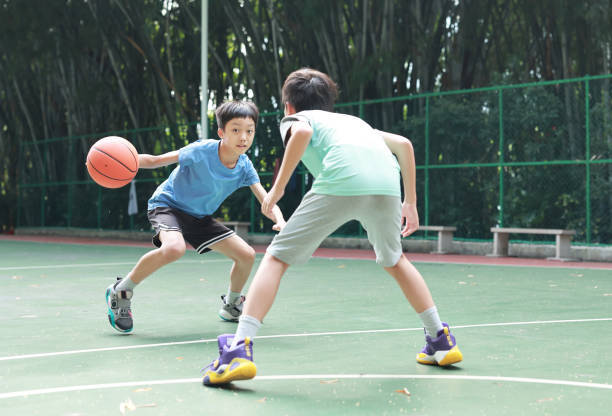BLOG: By Bobby Tingle

In the realm of player development and skills training, it is undeniable that highlights reign supreme. Social media feeds are inundated with dazzling crossovers, ankle-breaking moves, and perfect three-point shots. However, the crucial aspect of defense often goes unnoticed. While there may be occasional staged drill showcasing defensive techniques, genuine, game-like defensive practice is frequently neglected. It is essential to recognize that defense plays a vital role in player development, and integrating it into training routines can significantly enhance overall performance.
Changing the Perception of Work-Outs:
The duty of defense is shared by both skill trainers and player development coaches. It is essential to change the current perspective of the skills industry by moving from individual training sessions to small group formats. These group settings facilitate various defensive situations, such as 1-on-1, 2-on-1, and 2-on-2 drills, while also emphasizing defense over offense.
Skill development encompasses not only the comprehension of necessary tasks but also the perceptions and decisions that influence the use of biomechanical techniques. It is crucial to present the appropriate challenges for both offensive and defensive scenarios to ensure effective skill enhancement.
A coach with a robust defensive background can provide the ideal challenge for players. However, many coaches and trainers may find it difficult to create this level of intensity. While we can enhance players' perceptions and decision-making, the effectiveness of these skills may be compromised if our defensive or offensive abilities are not sufficiently developed. To ensure an optimal challenge, it is essential to engage in small group workouts against other players.
Defensive Movement Techniques and the ‘Defensive Slide’:
In basketball, players frequently find themselves needing to defend the ball or execute a close-out, and this necessity must be weighed against the frequency of more complex dribble moves being taught. As a coach, it is vital to develop a player's skills across all facets of the game, including offense, defense, and character development. To achieve this, coaches should focus on designing effective small-sided games (SSGs) that enhance individual defensive techniques. A key element of this training is the ability to utilize a variety of functional movement strategies for on ball defense, rather than relying on a singular method like the step slide. This outdated approach is insufficient for effectively guarding an offensive player. Therefore, it is advisable to avoid the term "slide" when discussing defensive movements, as it implies maintaining one foot on the ground, which can hinder speed and efficiency. Instead, the term "shuffle" better captures the lateral movement players need to effectively contain the ball.
The Crossover Step:
While shuffling is generally the best technique for ball defense, there are situations where a crossover step is necessary to maintain positioning against an offensive player who accelerates quickly or gains a shoulder-to-chest advantage. This challenges the common belief that crossing one's feet on defense is a mistake, highlighting the risks of coaching in absolutes. If defenders avoid crossing their feet, they may find it impossible to recover, leading to a cascade of defensive failures. In fact, crossing the feet can be a highly effective movement strategy, allowing defenders to contain the ball in critical moments. This technique is widely employed in various sports, such as tennis, football, lacrosse, and soccer, yet some basketball coaches and players remain reluctant to embrace it.
The Hip Turn:
The final technique to consider is the hip turn, which serves as a quicker alternative to the drop step for defensive recovery. Unlike the drop step, which is rarely utilized in actual games due to its slow execution, unnatural movement, and potential risk of knee injury, the hip turn allows defenders to respond more effectively when the ball handler begins to gain an advantage. This technique involves lifting both feet slightly off the ground, enabling the defender to pivot and face the direction of their intended cut-off. A cut-off involves selecting a specific spot on the court to intercept the offensive player, allowing the defender to re-establish a chest-to-chest position.

Traditional Defensive Teaching:
When a coach aims to enhance on-ball defense, a significant challenge arises from conventional defensive teaching methods, which often reflect the coaches' own experiences as players. Many traditional drills, such as lateral sliding and the zig-zag drill, fail to replicate real-game scenarios and thus prove ineffective. These exercises are positioned at the far end of the block practice continuum, emphasizing rote repetition rather than the dynamic nature of actual gameplay.
The effectiveness of various defensive techniques lies in their application in combination, adapting to the dynamic constraints of the game. For example, a defender may begin by shuffling to maintain optimal positioning while guarding the ball, but will quickly transition to a cross-step if the offensive player alters their speed. Should the offense gain a significant advantage, the defender might execute a hip turn, followed by another cross-step, and potentially revert to a lateral shuffle if necessary. Traditional drills often overlook the unpredictable nature of actual gameplay, failing to account for critical factors such as the positions of teammates and opposing players, the game clock, the score, and the offensive patterns being employed. Observing the footwork of a skilled on-ball defender during a game reveals that their techniques frequently contradict conventional coaching methods.
Why Defense in Player Development is Important:
The effectiveness of various defensive techniques lies in their application in combination, adapting to the dynamic constraints of the game. For example, a defender may begin by shuffling to maintain optimal positioning while guarding the ball, but will quickly transition to a cross-step if the offensive player alters their speed. Should the offense gain a significant advantage, the defender might execute a hip turn, followed by another cross-step, and potentially revert to a lateral shuffle if necessary. Traditional drills often overlook the unpredictable nature of actual gameplay, failing to account for critical factors such as the positions of teammates and opposing players, the game clock, the score, and the offensive patterns being employed. Observing the footwork of a skilled on-ball defender during a game reveals that their techniques frequently contradict conventional coaching methods.
How to Develop Defense in Player Development:
Coaches of players aged U12 and younger, should prioritize the development of offensive skills is essential. While some attention to defense is necessary, it should primarily focus on basic containment and guarding the ball, leaving more complex concepts like help rotations for older players. At this stage, there are numerous other critical skills that require attention. Incorporating functional movement solutions is vital for effective defensive play, and tag games serve as an excellent tool for this purpose, providing both enjoyment and skill development. Specifically, on-ball defensive movement should concentrate on lateral mobility, which tag games naturally promote through varied movement planes. Tailoring specific games to enhance lateral movement through strategic constraints is crucial for skill acquisition. Additionally, engaging in 1-on-1 scenarios within confined spaces can further develop the necessary functional movement skills, particularly when the focus is on achieving defensive stops and scoring.
Things to Focus On:
Here are things to consider emphasizing through well-designed SSG’s and appropriate task constraints.
- Defensive footwork movement patterns based on what transpires in the game
- Being able to wall-up and get vertical without fouling
- Chest stops
- Support and gap positioning
- Close-outs WITHOUT choppy steps (1-2 step)
- Defending the post
- Bumping cutters

At Player Development University, we are dedicated to helping basketball players of all levels unlock their true potential. My personal mission is to inspire players to reach excellence through the game of basketball. I have a unique perspective on the sport, having started my college basketball journey at the age of 22. Through my unconventional path, I have gained valuable experiences and lessons that I bring to every training session. Our programs are designed to cater to individual needs, allowing players to develop skills and techniques that will improve their game.
PDU also offer sports performance training for student-athletes. Coach Tingle is a Certified Strength and Conditioning Specialist (CSCS) through the NSCA. This certification is considered the "Gold Standard" in training athletes of all levels. Coach Tingle has many years of experience working with athletes from middle school through the college level.
Add comment
Comments